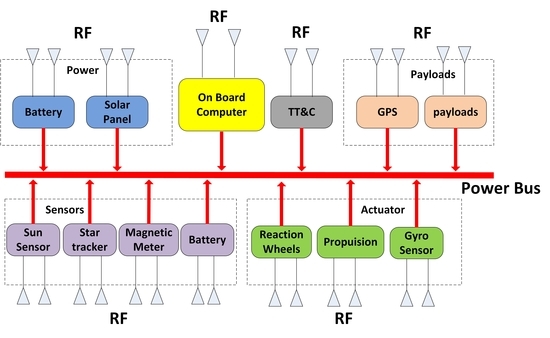A Hybrid TDMA/CSMA-Based Wireless Sensor and Data Transmission Network for ORS Intra-Microsatellite Applications
Abstract
:1. Introduction
2. Concepts and Structure
3. Physics Layer
4. MAC Protocol Design
4.1. Requirements Analysis
- Enough data rate for both payloads and subsystems;
- Delay performance guarantee for the time critical subsystems, such as AOC subsystem;
- Simple structure and support rapid development;
- Robustness and fault tolerance;
- Energy efficiency, since the available on-board power resources are limited.
4.2. Hybrid TDMA/CSMA
- TDMA-based Main Communication period (MCP);
- Backup communication period (BCP);
- CSMA/CA-based Extended Communication period (ECP);
4.3. Graded Tailoring Strategy
4.4. Adaptive Slot Allocation Method
4.4.1. Dynamic Slot Borrowing
4.4.2. Traffic Adaptive CSMA Slots Division
5. Markov Model and Calculations
5.1. Markov Model
- (1)
- During the backoff process, the backoff counter decreases when a slot arrives:
- (2)
- When the value of backoff counter reaches zero, a clear channel assessment (CCA) is performed. Data packets will be sent if CCA success. Let be the probability of a channel being occupied:
- (3)
- If the channel is occupied and CCA fails, the backoff stage increases and the value of backoff counter will be randomly chosen:
- (4)
- If a packet is successfully received, an ACK will be sent. Otherwise, the lack of ACK indicates a node collision event. Let denote the probability of node collision:
- (5)
- After a packet transmission, the backoff process will be restarted if the data buffer is not empty. Otherwise, the node will transit to the idle state:
- (6)
- When a collision occurs, the packet will be retransmitted unless it reaches the retransmission limit . In that case, it will be transited to the idle state or restart the backoff process with the same probability distribution in a successful transmission. Let denote the probability of retransmission, then we have:
- (7)
- At the end of the backoff process, when the backoff stage reaches its maximum, if the channel is still occupied, the transmission will be cancelled. Later, if new packets arrive, the backoff process will be restarted. Otherwise, the node becomes idle:
- (8)
- During the idle state, if a new packet arrives, the backoff process will be restarted. Otherwise, the node will remain idle. Let denote the probability of having no new packet, then we have:
5.2. Transmission under Unsaturated Traffic
5.3. Calculations
6. Simulations and Discussion
7. Conclusions
Author Contributions
Funding
Acknowledgments
Conflicts of Interest
Appendix A
| Symbol | Description | Symbol | Description |
|---|---|---|---|
| packet length (in slots) | Pr {one node is in transmitting} | ||
| length of the CSMA period | Pr {the network is in transmitting} | ||
| length of the CDMA period | Pr {node collision} | ||
| number of back off stage | Pr {network collision} | ||
| the ith backoff window size | Pr {packet discard} | ||
| size of backoff unit | Pr {packet discard due to collision} | ||
| Pr {CCA fail} | Pr {packet discard due to access failure} | ||
| Pr {node is performing CCA} | Pr {attempt success} | ||
| Pr {channel busy} | Pr {attempt and collision} | ||
| average service time for a packet | Pr {access failure} | ||
| throughput of the hybrid work | Pr {retransmission after collisions} | ||
| throughput of the CSMA period | average packet delay in CSMA period | ||
| throughput of the TDMA period | average power consumption in CSMA period |
References
- Dunbar, B. ORS-1 Launch Information. Available online: www.nasa.gov/centers/wallops/missions/ORS.html (accessed on 2 May 2018).
- Strunce, R.; Sorensen, B.; Mann, T. Training and Tactical Operationally Responsive Space (ORS) Operations (TATOO). In Proceedings of the International Conference on Recent Advances in Space Technologies, Perugia, Italy, 30 June–3 July 2008; pp. 93–96. [Google Scholar]
- Jiang, L.; Feng, J.; Shen, Y.; Xiong, X. Fast Recovery Routing Algorithm for Software Defined Network based Operationally Responsive Space Satellite Networks. KSII Trans. Int. Inf. Syst. 2016, 10, 2936–3951. [Google Scholar]
- Reese, K.; Martin, A.; Acton, D. STPSat-3: The Benefits of a Multiple-Build, Standard Payload Interface Spacecraft Bus. In Proceedings of the AIAA/USU Conference on Small Satellites, Logan, UT, USA, 4–7 August 2014. [Google Scholar]
- Mackey, R.; Brownston, L.; Castle, J.P.; Sweet, A. Getting Diagnostic Reasoning off the Ground: Maturing Technology with TacSat-3. IEEE Intell. Syst. 2010, 25, 27–35. [Google Scholar] [CrossRef]
- Anderson, L.C.M.; Raynor, B.; Hurley, M. TacSat-4: Military Utility in a Small Communication Satellite. In Proceedings of the AIAA/USU Conference on Small Satellites, Logan, UT, USA, 10–15 August 2013; pp. 846–851. [Google Scholar]
- Duffey, T.; Hurley, M.; Raynor, B.; Specht, T.; Weldy, K.; Bradley, E.; Amend, C.; Rossland, E.; Barnds, J.; Akins, K. TACSAT-4 Early Flight Operations Including Lessons From Integration, Test, and Launch Processing; Naval Research Lab: Washington, DC, USA, 2012. [Google Scholar]
- Guzmán-Miranda, H.; Barrientos-Rojas, J.; López-González, P.; Baena-Lecuyer, V.; Aguirre, M.A. On the Structural Robustness Assessment of Wireless Communication Systems for Intra-Satellite Applications. IEEE Trans. Nucl. Sci. 2014, 61, 3244–3249. [Google Scholar] [CrossRef]
- Jaffe, P.; Clifford, G.; Summers, J. SpaceWire for Operationally Responsive Space. In Proceedings of the Aerospace Conference, Big Sky, MT, USA, 1–8 March 2008; pp. 1–5. [Google Scholar]
- Sun, T.; Long, H.; Liu, B.C.; Li, Y. Application of side-oblique image-motion blur correction to Kuaizhou-1 agile optical images. Opt. Express 2016, 24, 6665–6679. [Google Scholar] [CrossRef] [PubMed]
- Sun, T.; Long, H.; Liu, B.C.; Li, Y. Application of attitude jitter detection based on short-time asynchronous images and compensation methods for Chinese mapping satellite-1. Opt. Express 2015, 23, 1395–1410. [Google Scholar] [CrossRef] [PubMed]
- Amini, R.; Aalbers, G.; Hamann, R.; Jongkind, W.; Beethuizen, P.G. New generations of spacecraft data handling systems: Less harness, more reliability. In Proceedings of the 57th International Astronautical Congress, Valencia, Spain, 2–6 October 2006. [Google Scholar]
- Plummer, C.; Plancke, P. Spacecraft harness reduction. Dasia 2002, 509, 57. [Google Scholar]
- Michelena, M.D.; Arruego, I.; Oter, J.M.; Guerrero, H. COTS-Based Wireless Magnetic Sensor for Small Satellites. IEEE Trans. Aerosp. Electron. Syst. 2010, 46, 542–557. [Google Scholar] [CrossRef]
- Li, S.; Fan, G.; Xu, G. Application of Wireless Satellite Bus in micro-satellite design. In Proceedings of the International Conference on Mechatronics and Automation, Changchun, China, 9–12 August 2009; pp. 2612–2616. [Google Scholar]
- Jongkind, W. The Dutch MST Program MicroNed and its Cluster MISAT. In Proceedings of the International Conference on Mems, nano and Smart Systems, Banff, AB, Canada, 24–27 July 2005; pp. 261–262. [Google Scholar]
- Guerrero, H. Trends and evolution of microsensors: Towards the 21st century transducing principles. In Proceedings of the 2nd International Conference on Integrated Micro/Nano-Technologies for Space, Pasadena, CA, USA, 11–15 April 1999. [Google Scholar]
- Arruego, I.; Guerrero, H.; Rodriguez, S.; Martinezoter, J.; Jimenez, J.J.; Dominguez, J.A.; Martinortega, A.; De Mingo, J.R.; Rivas, J.; Apestigue, V. OWLS: A ten-year history in optical wireless links for intra-satellite communications. IEEE J. Sel. Areas Commun. 2009, 27, 1599–1611. [Google Scholar] [CrossRef]
- Consultative Committee for Space Data Systems (CCSDS). Wireless Network Communications Overview for Space Mission Operations; CCSDS: Reston, VA, USA, 2005; pp. 42–47. [Google Scholar]
- Poves, E.; Campo, G.D.; Lopezhernandez, F.J.; Martingonzalez, J.A.; Gonzalez, O.; Rufo, J.; Perezjimenez, R. Wireless optical communications for intra-spacecraft networks based on OCDMA with random optical codes. IEEE Aerosp. Electron. Syst. Mag. 2012, 27, 36–41. [Google Scholar] [CrossRef] [Green Version]
- Bouwmeester, J.; Aalbers, G.T.; Ubbels, W.J. Preliminary Mission Results and Project Evaluation of the Delfi-C3 Nano-satellite. In Proceedings of the 4S Symposium 2008, Rhodes, Greece, 26–30 May 2008. [Google Scholar]
- Martin, M.; Fronterhouse, D.; Lyke, J. The Implementation of a Plug-and-play Satellite Bus. In Proceedings of the AIAA/USU Conference on Small Satellites, Los Angeles, CA, USA, 28 April–1 May 2008; pp. 11–14. [Google Scholar]
- De Boom, C.W.; Leijtens, J.A.P.; Duivenbode, L.V.; Van Der Heiden, N. Micro Digital Sun Sensor: System in a Package. In Proceedings of the 2004 International Conference on MEMS, NANO and Smart Systems (ICMENS 2004), Banff, AB, Canada, 25–27 August 2004; pp. 322–328. [Google Scholar]
- Eckersley, S.; Schalk, J.; Koppenhagen, K. The EADS micropack project—An intelligent microsystem demonstrator for small mission applications. In CANEUS 2006: MNT for Aerospace Applications; American Society of Mechanical Engineers: New York, NY, USA, 2006; pp. 129–134. [Google Scholar]
- Breukelen, E.D.V.; Bonnema, A.R.; Ubbels, W.J.; Hamann, R.J. DELFI-C3: Delft University of Technology’s Nanosatellite; (Special Publication) ESA SP; European Space Agency: Paris, France, 2006. [Google Scholar]
- Hamada, S.; Tomiki, A.; Toda, T.; Kobayashi, T. Wireless connections within spacecrafts to replace wired interface buses. In Proceedings of the Aerospace Conference, Big Sky, MT, USA, 2–9 March 2013; pp. 1–9. [Google Scholar]
- Zhou, L.; An, J.; Xie, Y.; Xiong, W.; Xue, C. Design of the network protocol of a wireless spacecraft high speed data network. J. Nat. Univ. Def. Technol. 2014, 34, 127–136. [Google Scholar] [CrossRef]
- Drobczyk, M.; Martens, H. A study on low-latency wireless sensing in time-critical satellite applications. In Proceedings of the 2016 IEEE Sensors, Laguna Beach, CA, USA, 22–25 February 2016. [Google Scholar]
- Vladimirova, T.; Fayyaz, M. Wireless Fault-Tolerant Distributed Architecture for Satellite Platform Computing. In Proceedings of the International Conference on Hybrid Information Technology, Daejeon, Korea, 23–25 August 2012; pp. 428–436. [Google Scholar]
- Poulakis, M.I.; Vassaki, S.; Panagopoulos, A.D. Satellite-based wireless sensor networks: Radio communication link design. In Proceedings of the European Conference on Antennas and Propagation, Gothenburg, Sweden, 8–12 April 2013; pp. 2620–2624. [Google Scholar]
- Zhou, L. The Research on Intra-spacecraft Wireless Sensor Network. Chin. J. Space Sci. 2012, 32, 846–854. [Google Scholar]
- Vladimirova, T.; Bridges, C.P.; Prassinos, G.; Wu, X.; Sidibeh, K.; Barnhart, D.J.; Jallad, A.H.; Paul, J.R.; Lappas, V.; Baker, A. Characterising Wireless Sensor Motes for Space Applications. In Proceedings of the Adaptive Hardware and Systems 2007 (AHS 2007), Edinburgh, UK, 5–8 August 2007; pp. 43–50. [Google Scholar]
- Ferro, E.; Potorti, F. Bluetooth and Wi-Fi wireless protocols: A survey and a comparison. IEEE Wirel. Commun. 2005, 12, 12–26. [Google Scholar] [CrossRef]
- Santangelo, A. OpenSAT(TM) and SATBuilder: A Satellite Design Automation Environment for Responsive Space. In Proceedings of the Aiaa Aerospace Sciences Meeting and Exhibit 2013, San Diego, CA, USA, 24–27 June 2013. [Google Scholar]
- Gu, D.; Lai, Y.; Liu, J.; Ju, B.; Jia, T. Spaceborne GPS receiver antenna phase center offset and variation estimation for the Shiyan 3 satellite. Chin. J. Aeronaut. 2016, 29, 1335–1344. [Google Scholar] [CrossRef]
- Wang, F.; Kang, Y.; Tan, X.; Yu, K. A hybrid MAC protocol for data transmission in Smart Grid. In Proceedings of the Conference on Computational Complexity 2014, Portland, OR, USA, 17–19 June 2015; pp. 8228–8233. [Google Scholar]
- Nguyen, V.; Oo, T.Z.; Chuan, P.; Hong, C.S. An Efficient Time Slot Acquisition on the Hybrid TDMA/CSMA Multichannel MAC in VANETs. IEEE Commun. Lett. 2016, 20, 970–973. [Google Scholar] [CrossRef]
- Rhee, I.; Warrier, A.; Aia, M.; Min, J. Z-MAC: A hybrid MAC for wireless sensor networks. In Proceedings of the International Conference on Embedded Networked Sensor Systems 2005, San Diego, CA, USA, 2–4 November 2005; pp. 90–101. [Google Scholar]
- Song, W.; Huang, R.; Shirazi, B.; Lahusen, R. TreeMAC: Localized TDMA MAC protocol for real-time high-data-rate sensor networks. In Proceedings of the IEEE International Conference on Pervasive Computing and Communications, Galveston, TX, USA, 9–13 March 2009. [Google Scholar]
- Durmaz, O.; van Hoesel, L.F.W.; Jansen, P.G.; Havinga, P.J.M. MC-LMAC: A multi-channel MAC protocol for wireless sensor networks. Ad Hoc Netw. 2011, 9, 73–94. [Google Scholar]
- Kim, T.H.; Choi, S. Priority-based delay mitigation for event-monitoring IEEE 802.15.4 LR-WPANs. IEEE Commun. Lett. 2006, 10, 213–215. [Google Scholar]
- Patro, R.; Raina, M.; Ganapathy, S.V.; Shamaiah, M.; Thejaswi, P.S.C. Analysis and improvement of contention access protocol in IEEE 802.15.4 star network. In Proceedings of the Mobile Adhoc and Sensor Systems 2007, Pisa, Italy, 8–11 October 2007; pp. 1–8. [Google Scholar]
- Son, K.J.; Cho, H.; Hong, S.H.; Moon, S.; Chang, T.G. New enhanced clear channel assessment method for IEEE 802.15.4 network. In Proceedings of the International Soc Design Conference 2015, Austin, TX, USA, 2–6 November2015; pp. 251–252. [Google Scholar]
- Lee, B.; Lai, R.; Wu, H.; Wong, C. Study on Additional Carrier Sensing for IEEE 802.15.4 Wireless Sensor Networks. Sensors 2010, 10, 6275–6289. [Google Scholar] [CrossRef] [PubMed]
- Wen, H.; Lin, C.; Chen, Z.; Yin, H.; He, T.; Dutkiewicz, E. An Improved Markov Model for IEEE 802.15.4 Slotted CSMA/CA Mechanism. J. Comput. Sci. Technol. 2009, 24, 495–504. [Google Scholar] [CrossRef]
- Amini, R.; Eberhard, G.; Georgi, G. The Challenges of Intra-Spacecraft Wireless Data Interfacing. In Proceedings of the 58th International Astronautical Congress, Hyderabad, India, 24–28 September 2007. [Google Scholar]
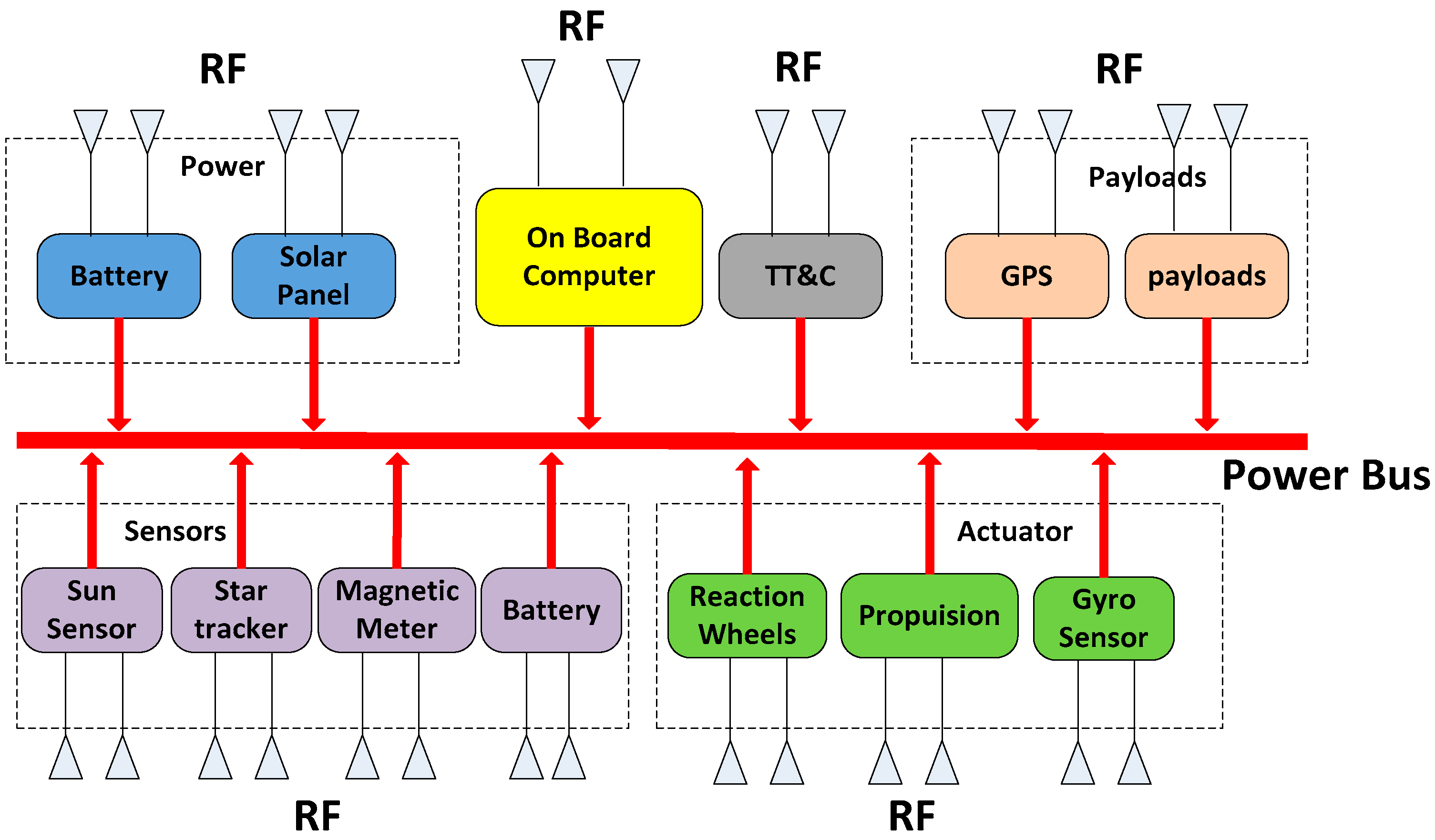

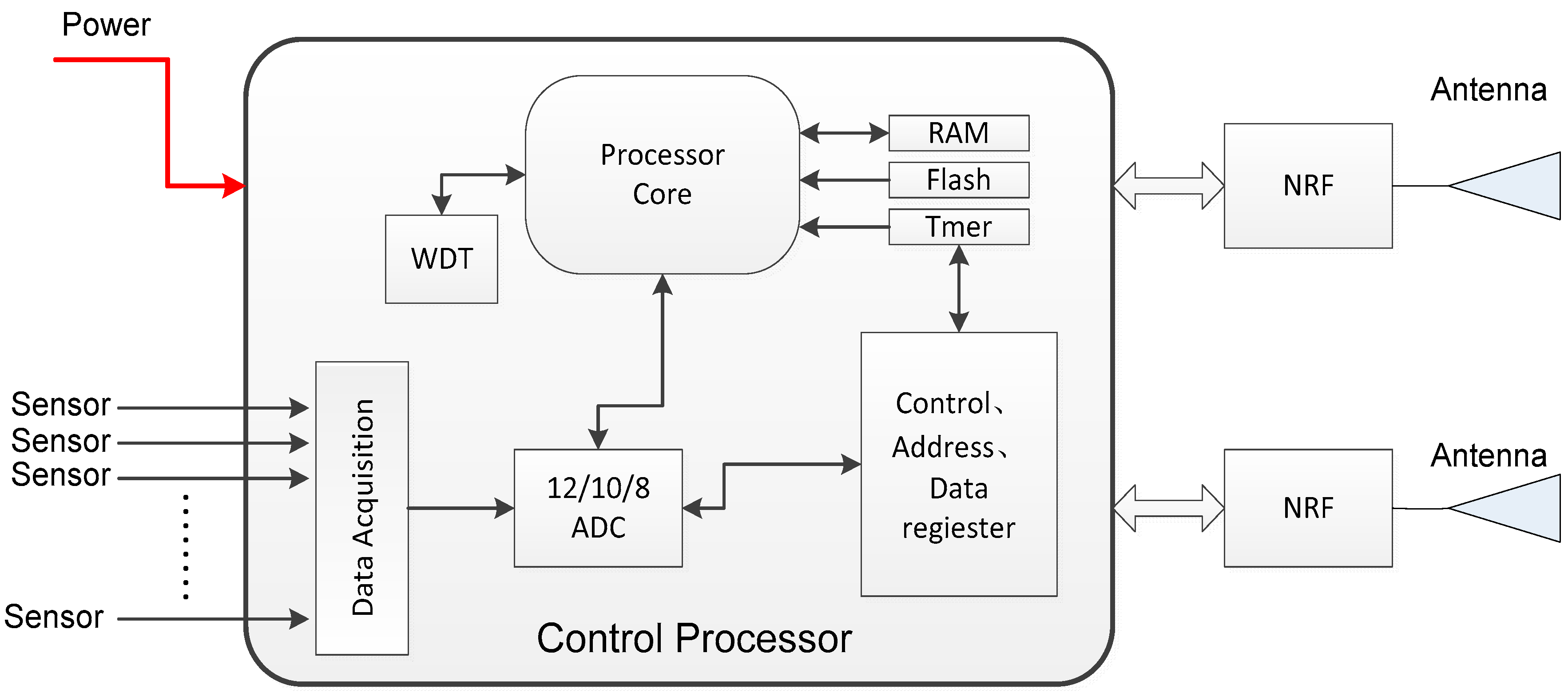


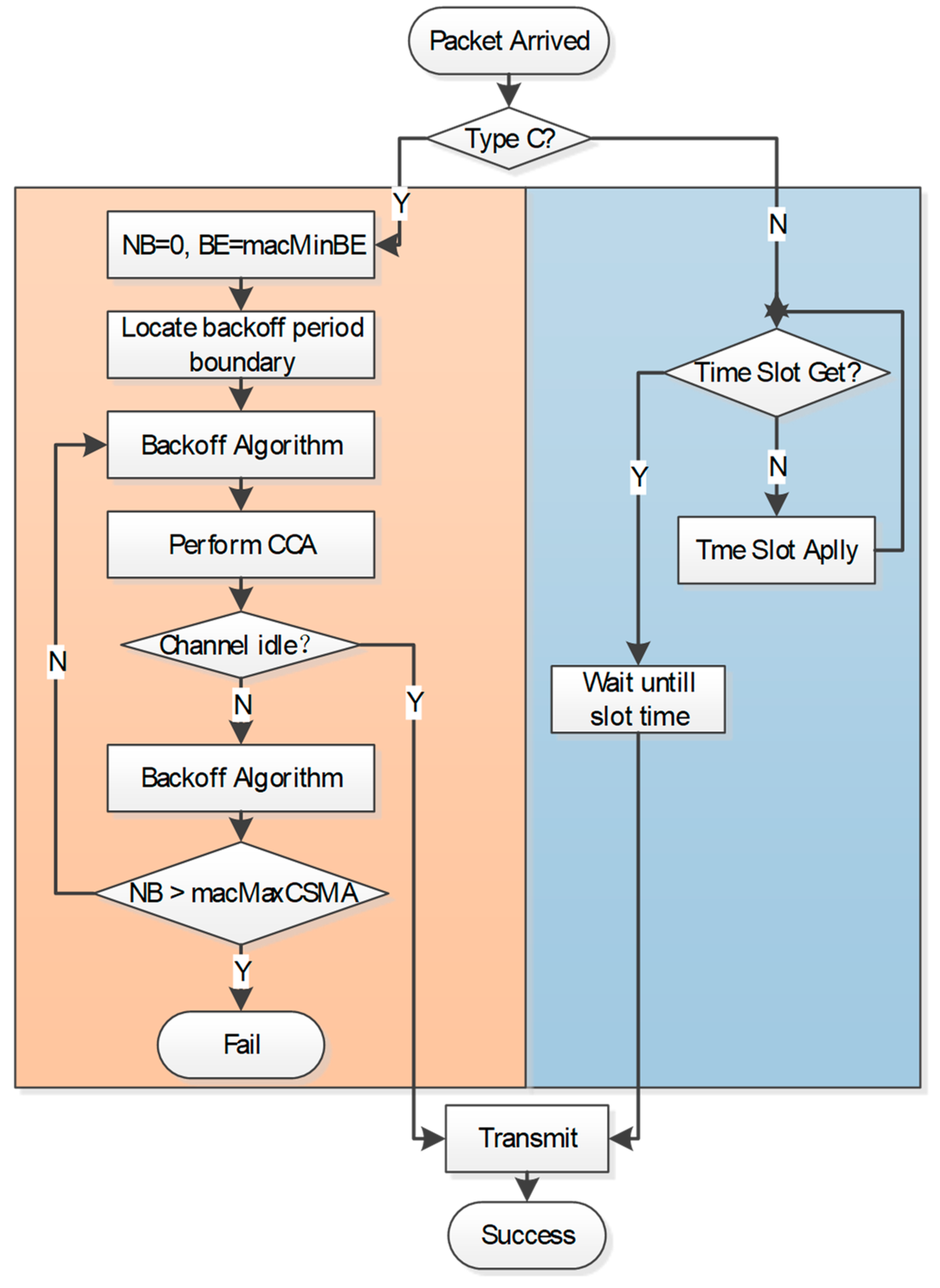


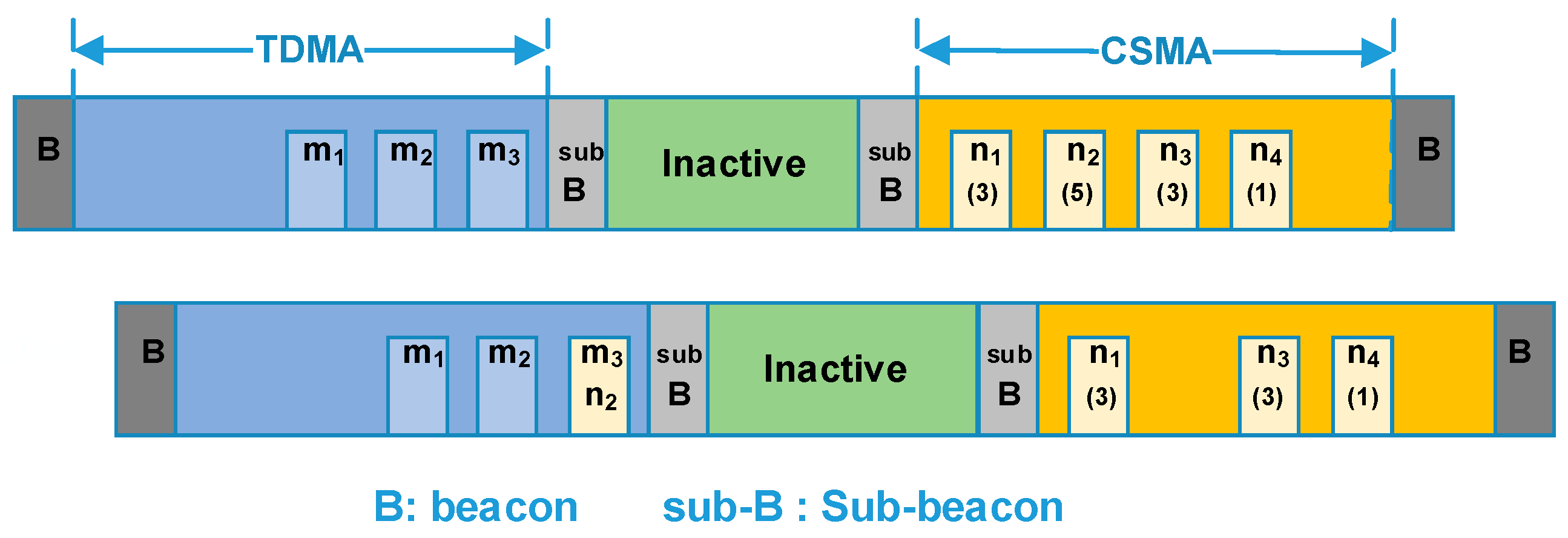
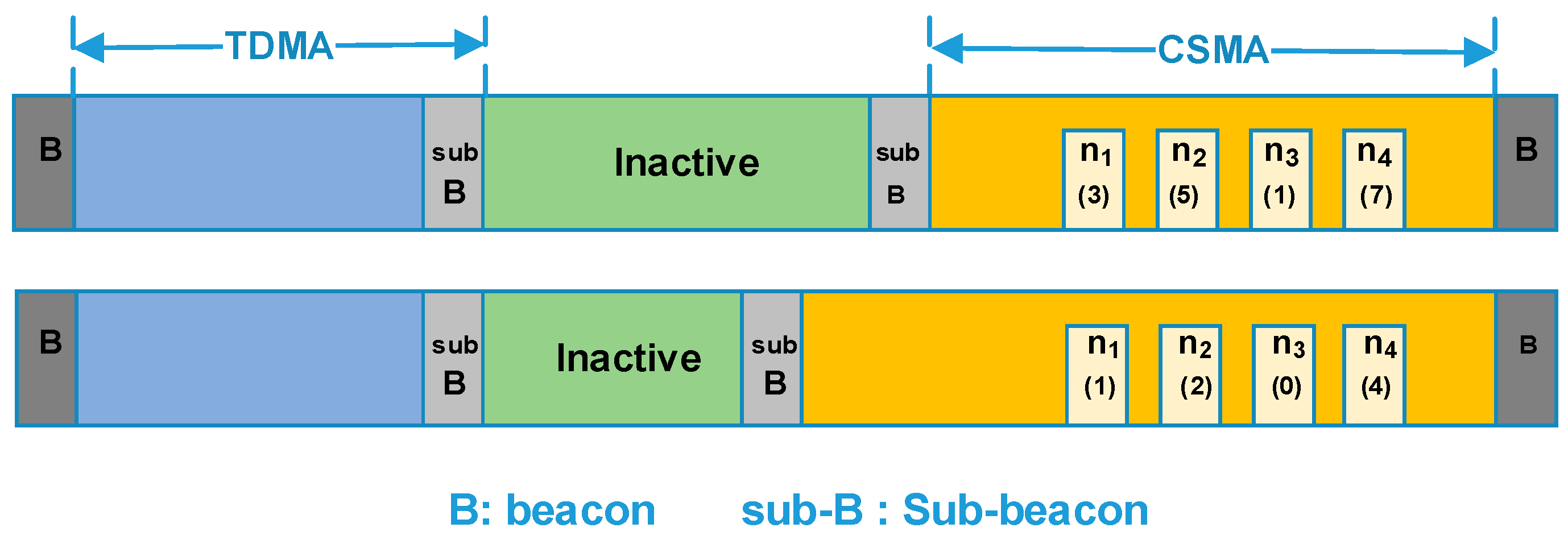
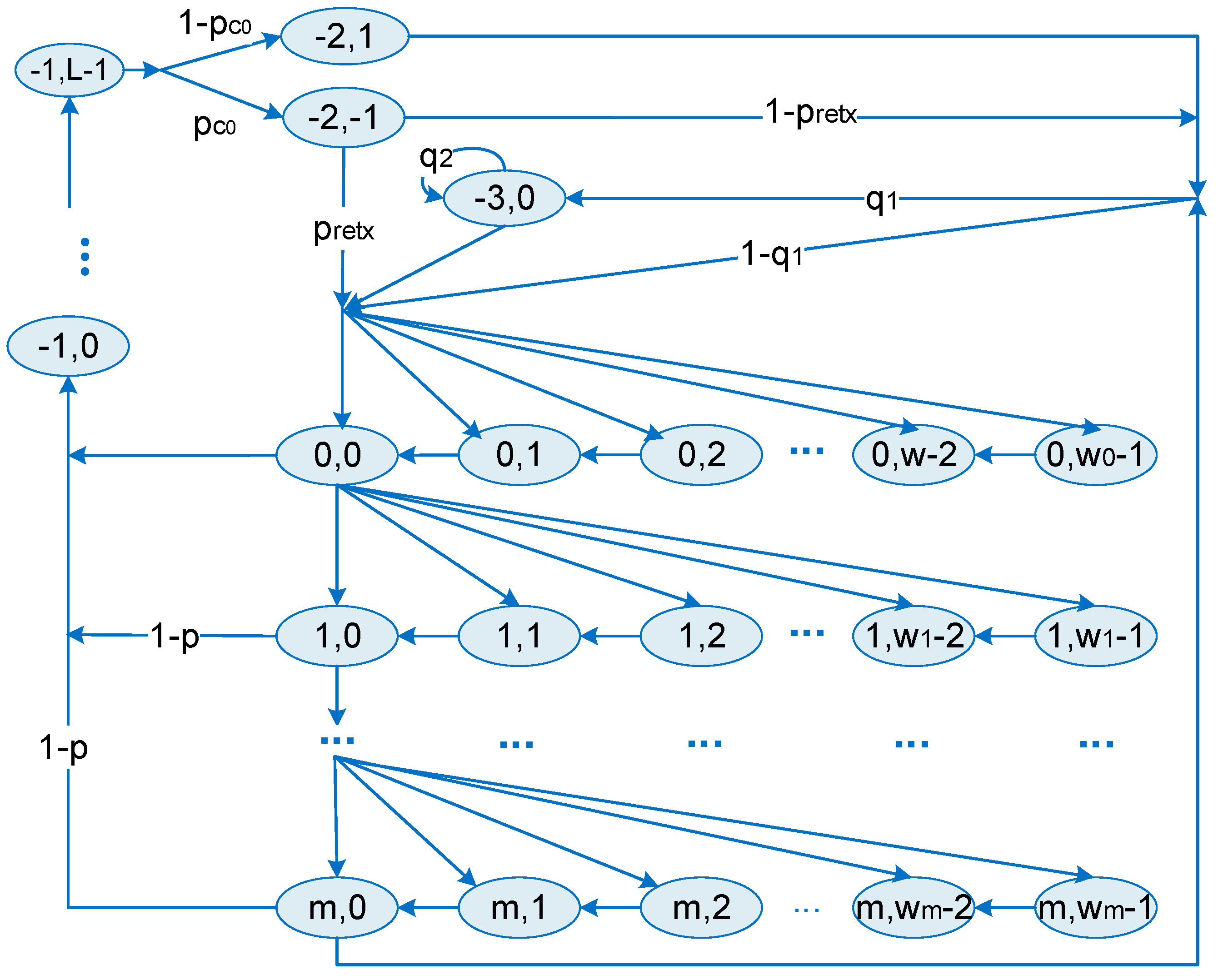
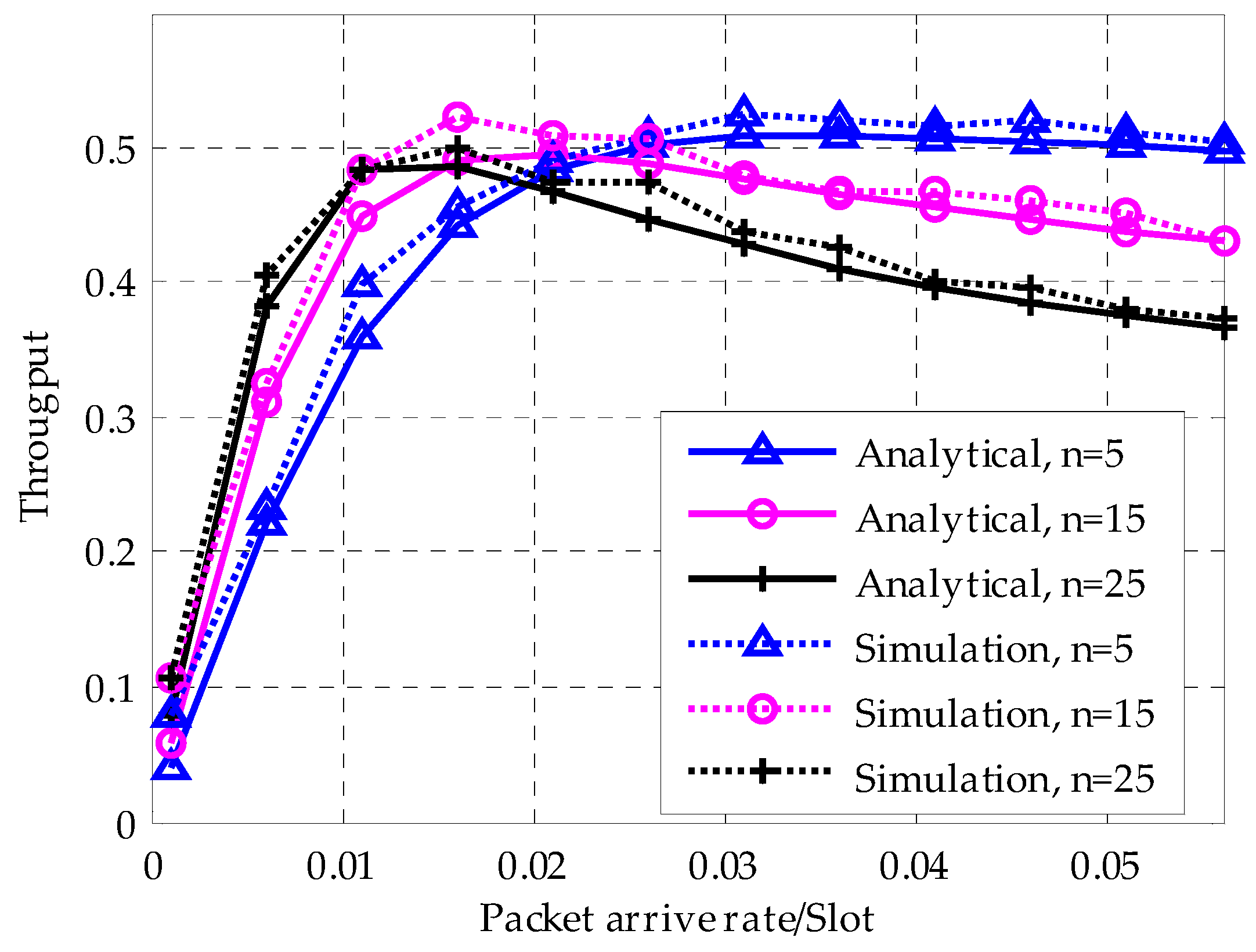
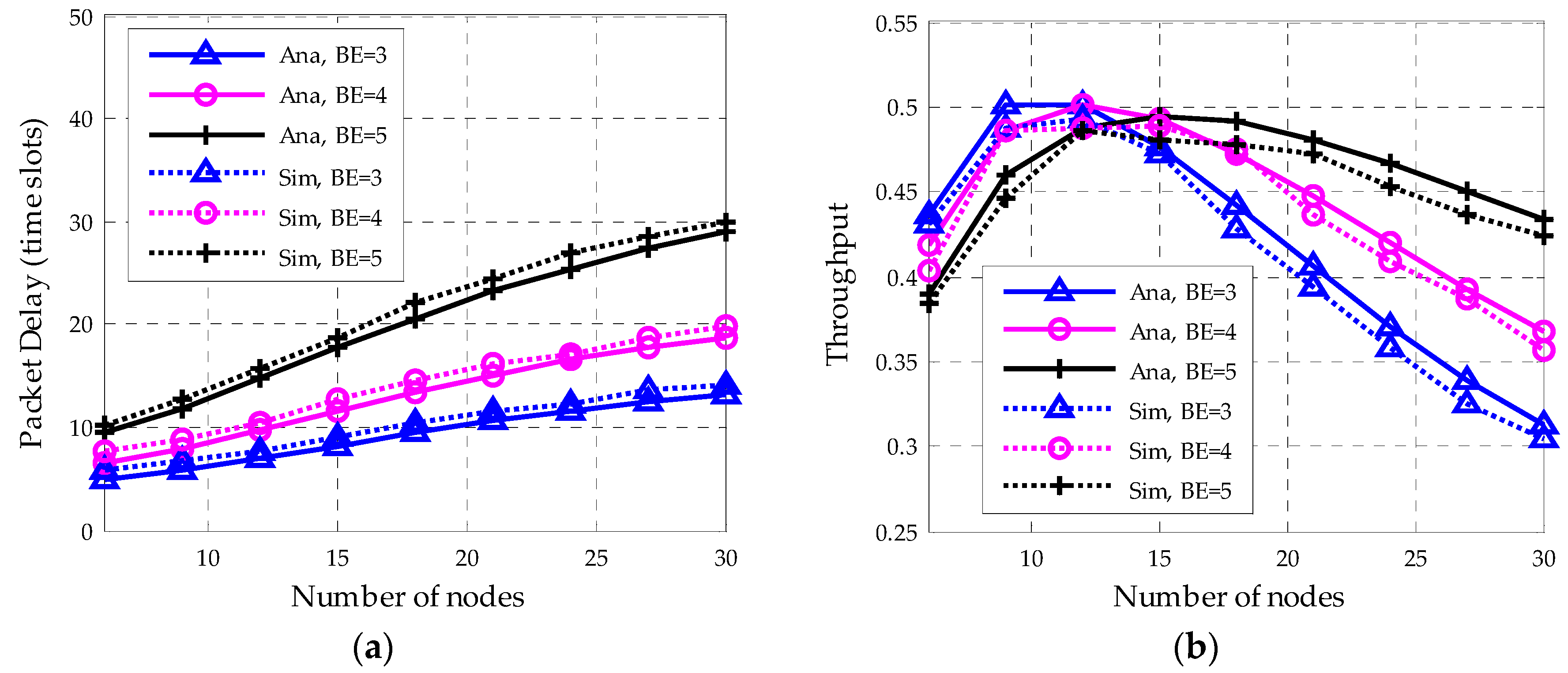


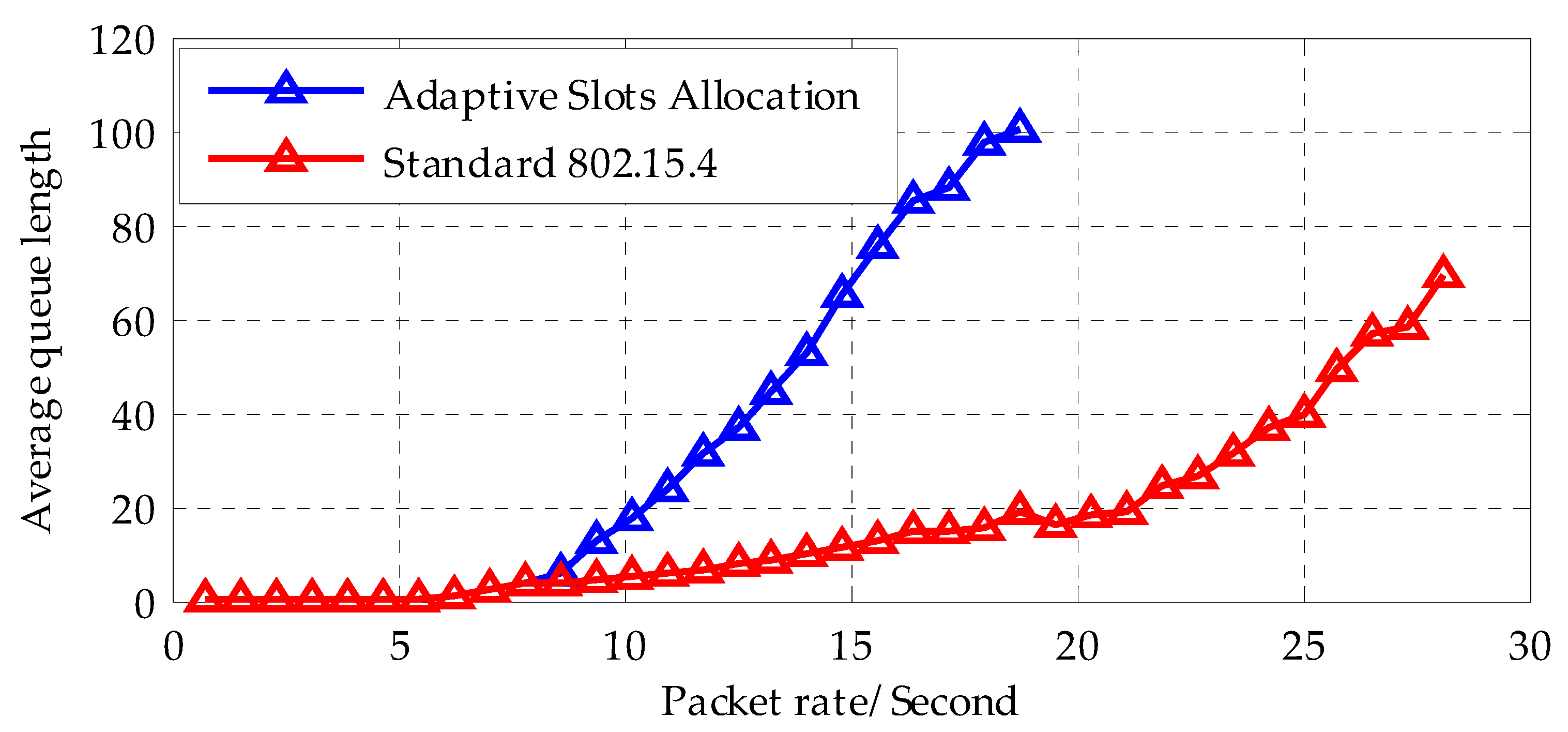
| Parameters | Value | Units |
|---|---|---|
| Micro Processor | ||
| Program memory | 64 | KB |
| RAM | 4352 | Byte |
| Active Power | 27 | mW |
| Sleep Power | 27 | μW |
| Storage Size | 64 | KB |
| RF transceiver | ||
| Data rate | 500 | Kbps |
| Receive power | 40 | mW |
| Transmit power at 0 dBm | 68 | mW |
| ISWN Node | ||
| Total Active power | 143 | mW |
| Type | Data Rate | Delay | Examples |
|---|---|---|---|
| A | High | Sensitive & insensitive | Payloads, on-board computer, telemetering and tele-control system, power management system, etc. |
| B | Low | Sensitive | Thrusters, reaction wheels, GPS, gyroscope, magnetometer, star camera, Sun sensors, etc. |
| C | Low | Insensitive | Thermal subsystem, mechanical subsystem temperature sensors, solar panel and other sensors |
| Graded Tailoring Strategy |
|---|
| X: the original length of the data packet in the last unit Y: the size of the packet tail after the graded tailoring N: the partition point Check the length of the physics layer data unit (PPDU) If |
| Adaptive Slots Allocation Method |
|---|
| : Slots division index : Maximum of borrowed slots : Number of idle slots : Slots occupation matrix in the TDMA period : List of idle slots in the TDMA period : Queue counter value of node i : Average queue counter value of received data packets : acceptable average queue threshold : Slots number in the CSMA period entry 1 |
| Start Collect the data packets in the CSMA period and calculate refresh Count the number of idle slots and find the last idle slot Sort and find the largest value If then end Wait for the next superframe If then Stop |
© 2018 by the authors. Licensee MDPI, Basel, Switzerland. This article is an open access article distributed under the terms and conditions of the Creative Commons Attribution (CC BY) license (http://creativecommons.org/licenses/by/4.0/).
Share and Cite
Wang, L.; Liu, Y.; Yin, Z. A Hybrid TDMA/CSMA-Based Wireless Sensor and Data Transmission Network for ORS Intra-Microsatellite Applications. Sensors 2018, 18, 1537. https://doi.org/10.3390/s18051537
Wang L, Liu Y, Yin Z. A Hybrid TDMA/CSMA-Based Wireless Sensor and Data Transmission Network for ORS Intra-Microsatellite Applications. Sensors. 2018; 18(5):1537. https://doi.org/10.3390/s18051537
Chicago/Turabian StyleWang, Long, Yong Liu, and Zengshan Yin. 2018. "A Hybrid TDMA/CSMA-Based Wireless Sensor and Data Transmission Network for ORS Intra-Microsatellite Applications" Sensors 18, no. 5: 1537. https://doi.org/10.3390/s18051537



